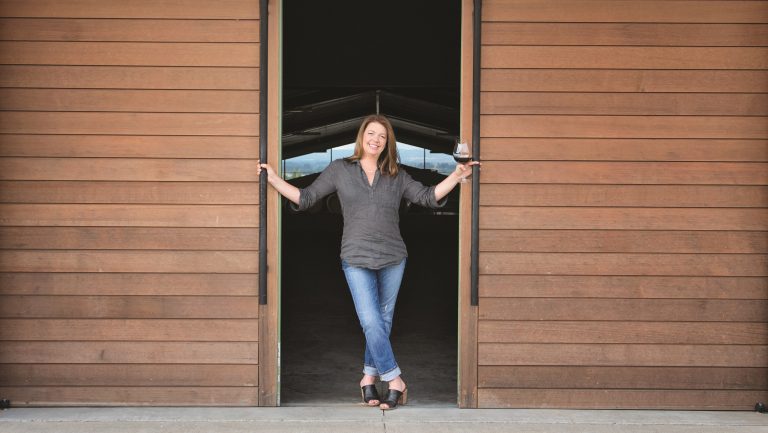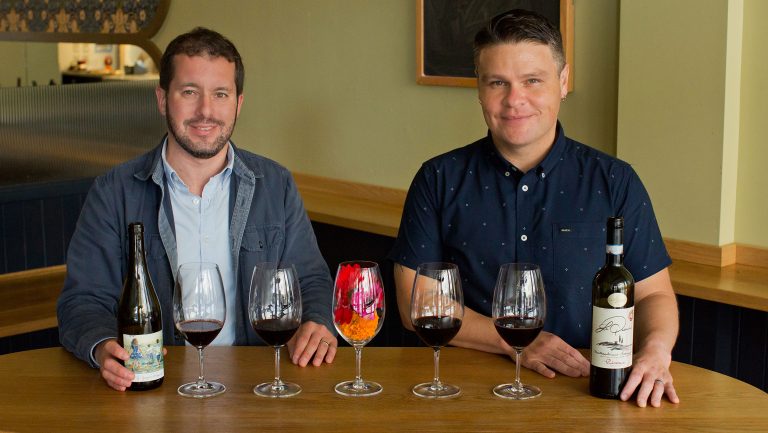Originally, Luisa Ponzi, the director of winemaking and viticulture at Ponzi Vineyards in the Willamette Valley, didn’t plan to go into the family business. It was only after she reconsidered her intended career in medicine that she returned to work alongside her parents. By the early 1990s, both of her siblings had returned to the business too.
This ended up creating an ideal scenario for founders Dick and Nancy Ponzi, who were ready to move on to new adventures by the 1990s. By 1995, the second generation was basically running the winery. In 2001, the children bought out their parents and took on ownership. “It was all very organic,” says Luisa. “It was a very smooth process that happened over time. It’s a blip in my memory.”
When the Ponzi family was ready to transition the business a second time, however, things were a little less organic. By 2020, Luisa’s brother Michel had already left, and Luisa and her sister Anna Maria felt the 50-year-old brand could use a new perspective and some new energy. They started looking for a potential buyer and were thrilled when Bollinger, another family business, expressed interest.

Don’t miss the latest drinks industry news and insights. Sign up for our award-winning newsletters and get insider intel, resources, and trends delivered to your inbox every week.
The sale to Bollinger took about a year. In addition to numerous legal transactions (made more complex by the fact that it was an international deal and the pandemic was in full swing), it involved countless hours of the two brands getting to know and understand each other.
The Ponzi family counts itself lucky to have made it through two rounds of succession with results that felt like a win-win. Not all brands have such an easy path. There may not be a second or third generation interested in taking on the business, and even if there is, parents, siblings, and cousins may not always see eye to eye on how to manage the company, bringing up conversations that are personally and professionally painful.
When an outside buyer is the answer for succession, brands can still face many challenges. Appropriate buyers don’t always show up immediately, and a brand may not fetch a good price unless it has real value to offer the new owner. It can take years to get a brand into a strong position to be sold.

Making a Succession Plan
Planning for the passage of a company from one set of owners to the next is one of the smartest things a business owner can do. Though it may seem counterintuitive, the best time to start that planning is when the business is still in startup mode.
Part of the reason, according to Phillip Kalsched, an attorney at Carle, Mackie, Power & Ross LLP in Santa Rosa, California, who has helped many firms through the succession process, is that knowing what a potential exit strategy looks like helps business owners make smart choices while they’re building the brand. “Decisions you make along the way—whether it’s buying a vineyard, adding production, or growing club membership—have impacts on the valuation for any business,” he says. If you’re working within an overall plan, it can help drive those decisions and better ensure the owners are set up for a profitable exit.
Transitioning a business to a family member, employee cooperative, or outside buyer takes time. If brands hold off on succession planning until the owners are a few years away from retirement, there’s so much pressure to make decisions that it’s easier to make poorly reasoned ones, says Kalsched. There’s less time for people to transition into new roles and be mentored by existing owners to ensure an orderly transition. If succession is forced by the injury or death of an owner, the process can be even more chaotic.
“Invariably, things will change,” says Kalsched. “If you create a plan 25 years before you’re ready to retire, the beauty is that the plan doesn’t have to be static. It can evolve and change as your situation changes.”
The Succession Team
According to Luisa Ponzi, having a trusted group of experienced advisors was one of the critical factors in their successful sale to Bollinger. They worked with a team of people who were well versed in the process of selling a beverage business and had done many similar transactions in the past. They were instrumental in guiding the family through the many steps involved in the process.
Experts agree that putting together a succession planning team is important. Beyond leaders within the company, this group is likely to include lawyers, who can create contracts, bylaws, and other key documents; accountants, who can advise business owners on the tax, estate planning, and other financial implications of different strategies; and a mergers and acquisitions specialist, particularly if the brand is being purchased and needs a valuation.

“I also think it’s important in family businesses, especially ones that are thinking about having the next generation operate the business, to have an outside third-party advisory group. It can be really critical in creating that transitional buffer between the founding generation and the next generation,” says Kalsched. An advisory board might consist of friends and colleagues with experience in the beverage business, as well as attorneys and accountants.
Jim Andersen, a partner at the financial consulting firm Hemming Morse, which has offices around California, is often brought in as, what Anderson calls, a “quarterback” for the succession planning process. He coordinates the various players and acts as an intermediary to make sure the process runs smoothly.
Transitioning a Business to Family Members
When possible, many owners choose to pass their business to a second generation. Since family dynamics can be tricky, it’s especially important for members to get involved early and come up with a shared vision for how the business will be run.
Andersen’s quarterback concept can be particularly helpful with family businesses. He will often query parents about their plans for children’s roles and ownership levels, then come up with a plan for how to structure the new leadership team.
“One of the biggest problems with a family business is that parents will try to be equal,” he says. “In a business, there’s no such thing as fair, and [trying to be] equal is sometimes a bigger disaster.” Having someone from outside the family make tough calls and break potential bad news can make that whole process go more smoothly.
One way to avoid family feuds is to break up the company. Andersen has successfully worked with wine brands that transferred the winery to one family member and the vineyards to another. That way, family members can work in partnership with each other without having to make all the decisions together or having as close a financial tie.
With a plan for succession in place, it’s imperative to put everything in writing. Two key points to cover in documents are leadership structure and exit strategy. “There’s always going to have to be someone who’s the head of the company,” says Kalsched. “How that person is nominated, elected, or brought into the business should be laid out in the formation or operating documents of the business.”
Kalsched also implores brands to clearly spell out how family members can exit the business without throwing it into financial peril. Buy-sell agreements can also be spelled out as part of formational documentation.
Be sure to speak with a CPA to discuss the tax and estate planning implications of gifting a business to children. This is another place where advance strategizing can make a tremendous difference in the bottom line.

Selling the Business
“If there’s no clear path to family members running the business, then the answer is to just sell,” says Andersen. There are, however, multiple options for selling a beverage brand.
One is to sell to an employee cooperative. As with family businesses, it’s critical to identify key players who want to continue in the business early on, and work closely with them to come up with a leadership and transition plan.
Another option is to sell to another beverage business. “We see a tremendous amount of consolidation, especially in the wine industry,” says Kalsched. Besides allowing the brand to continue in its current form, this type of sale may also give the brand access to new markets and paths to further growth.
Owners can also sell to a private equity firm, such as Altria’s recent sale of Chateau Ste. Michelle. Private equity firms often want the owners to transfer the majority of their interest to the firm, but not all of it. “That puts pressure on the owners to not only stay involved for a period of time, but also gives them a financial interest to continue to grow,” says Kalsched. That may be good or bad, depending on the owner’s plans for their own future.
“With an equity group, [the owner] is going to have someone looking over their shoulder that they have to report to,” Kalsched points out, which may be hard for entrepreneurs used to going it alone. Private equity firms are also more likely to take on debt, which can be a big shock to folks who are debt averse.
Securing a Valuation
When a sale is involved, one of the biggest sticking points may be the business’s valuation. “Many owners have a false sense of what their business is worth,” says Andersen. Again, that’s why it’s critical to start succession planning early. If owners understand what decisions will add value to their businesses, they can make smart choices years before they’re ready to sell.
Joe Ciatti with Zepponi & Company specializes in mergers and acquisitions. He encourages brands thinking about a future sale to emphasize profit over growth. “We have some wineries that really like growth. What profits they do have, oftentimes they have to take those and put them back into buying vineyards or new equipment,” he says. “If you don’t show profits, growth means something, but it doesn’t mean as much.”
He recommends finding an advisor who can help structure the company with the goal of earning a high valuation. Besides focusing on profit, that person may advise paying down debt or selling off some portion of the business that isn’t profitable.
Luisa Ponzi advises business owners to remain patient. “Buckle up and realize it’s a long process,” she says. “Every time we celebrated some phase of the transition, there was a new list of things we had to get done for the next phase. It was so much more complex than we expected.”

Other Profit Options
Another option for owners looking to retire is to sell off assets, such as distilling equipment or vineyards, but maintain ownership of the brand. This can be an ideal scenario if there are family members or other interested parties who love being in the drinks business but aren’t interested in running the day-to-day operations. Production can be farmed out to third-party vendors, or the name can be licensed to someone else.
If the owner, family members, and employees have no interest in keeping the company going, it may make sense to simply close everything down and liquidate the assets.
Though selling a business can be a way to fund retirement, there’s no guarantee it will generate enough money to live on—or any profit at all. “First and foremost, when you start a business, you want to look at some type of pension or 401K plan,” says Ciatti. If the business has employees, owners can set up a plan that everyone can participate in, or they can invest independent of the business. When Ciatti sold his first business, an international wine brokerage company, he actually had more in his retirement fund than he got for the company.
If succession is properly planned for, though, generating a profit is more likely. “Plan early, plan often,” is Kalsched’s motto. “You can’t start thinking about the exit strategy early enough.”

Dispatch
Sign up for our award-winning newsletter
Don’t miss the latest drinks industry news and insights—delivered to your inbox every week.
Sophia McDonald is a freelance writer who lives in Eugene, Oregon. Her work has appeared in numerous publications and on websites, including Wine Enthusiast, Eating Well, Sip Northwest, and 1859 Oregon’s Magazine.







